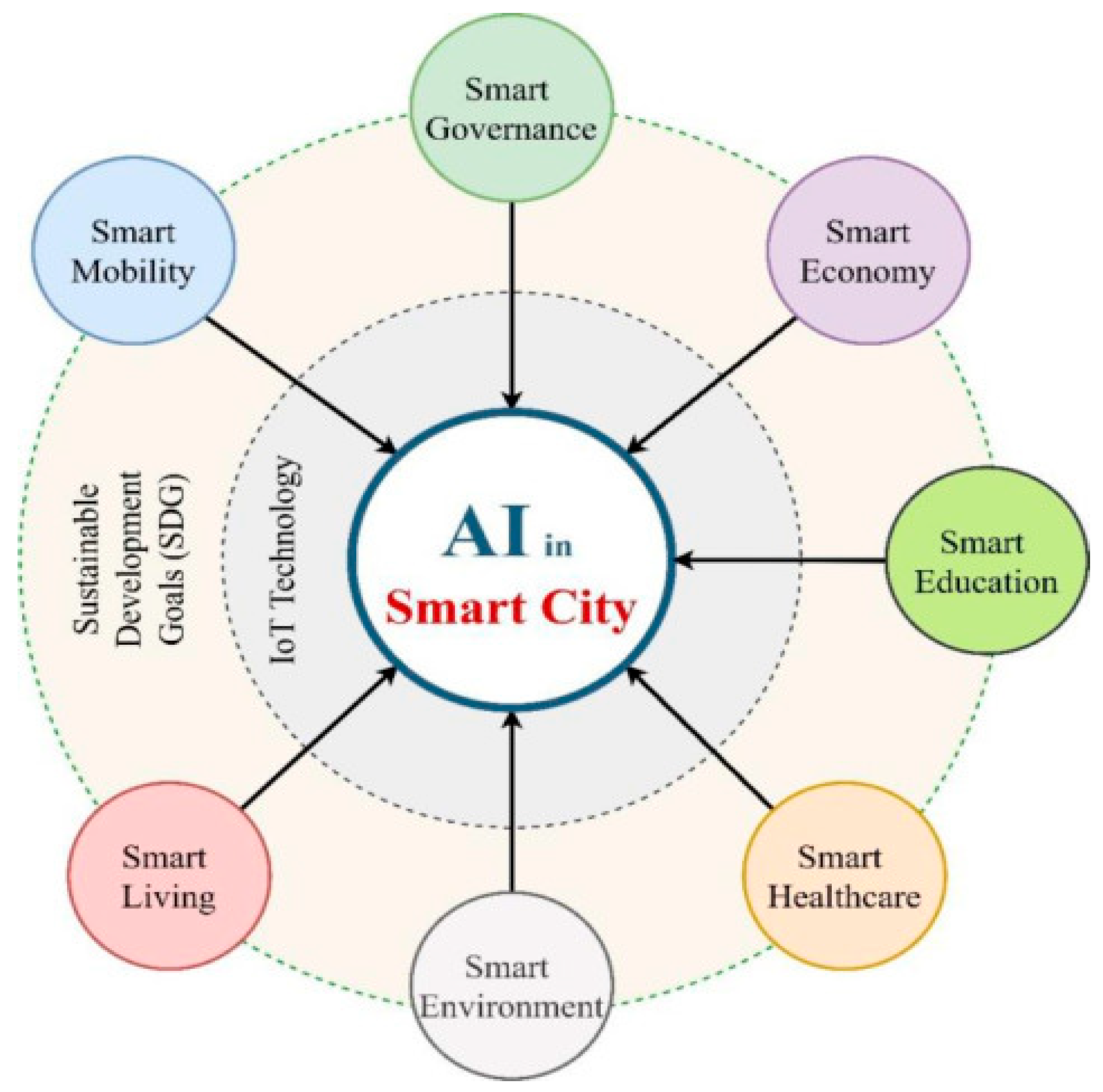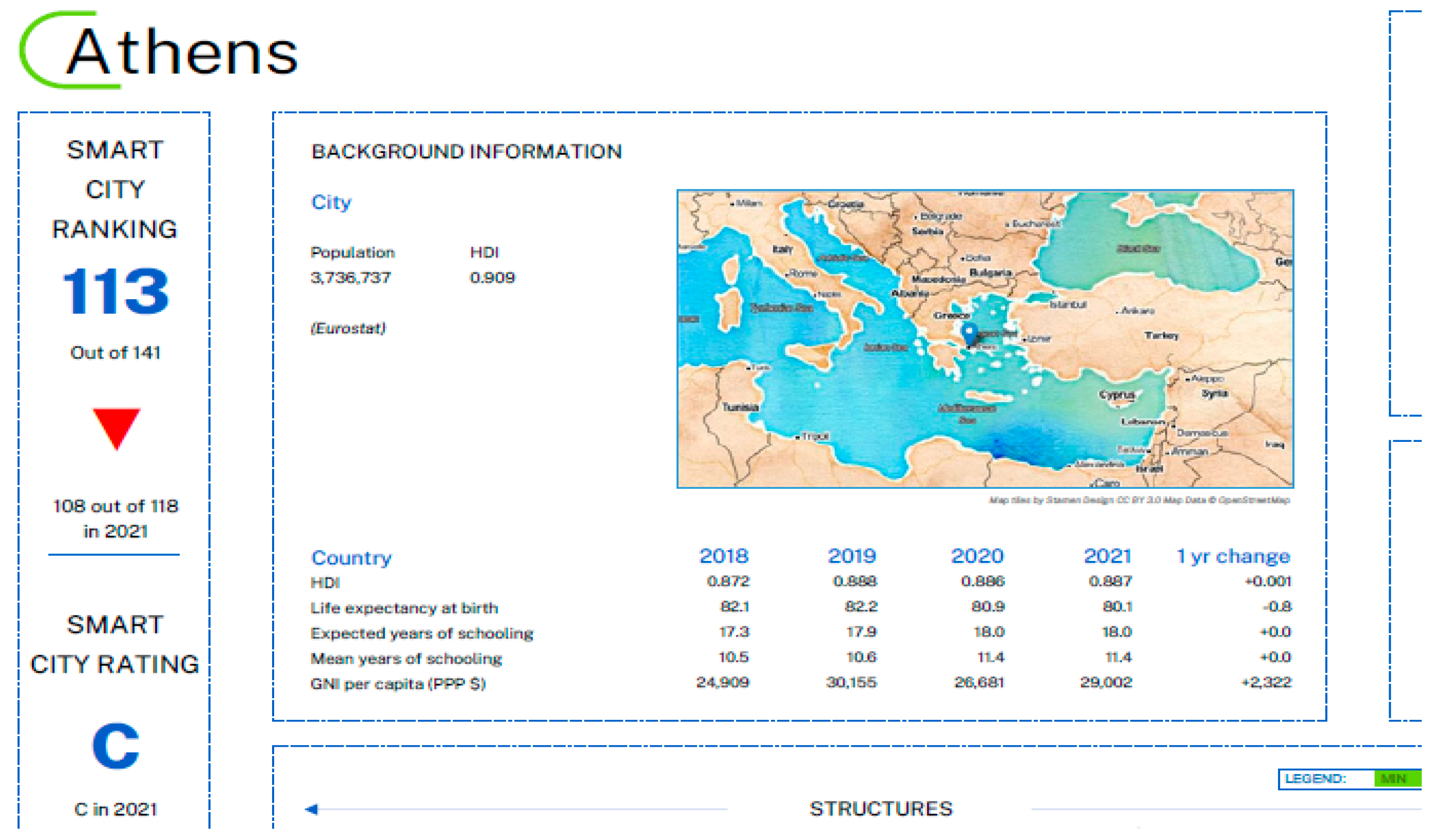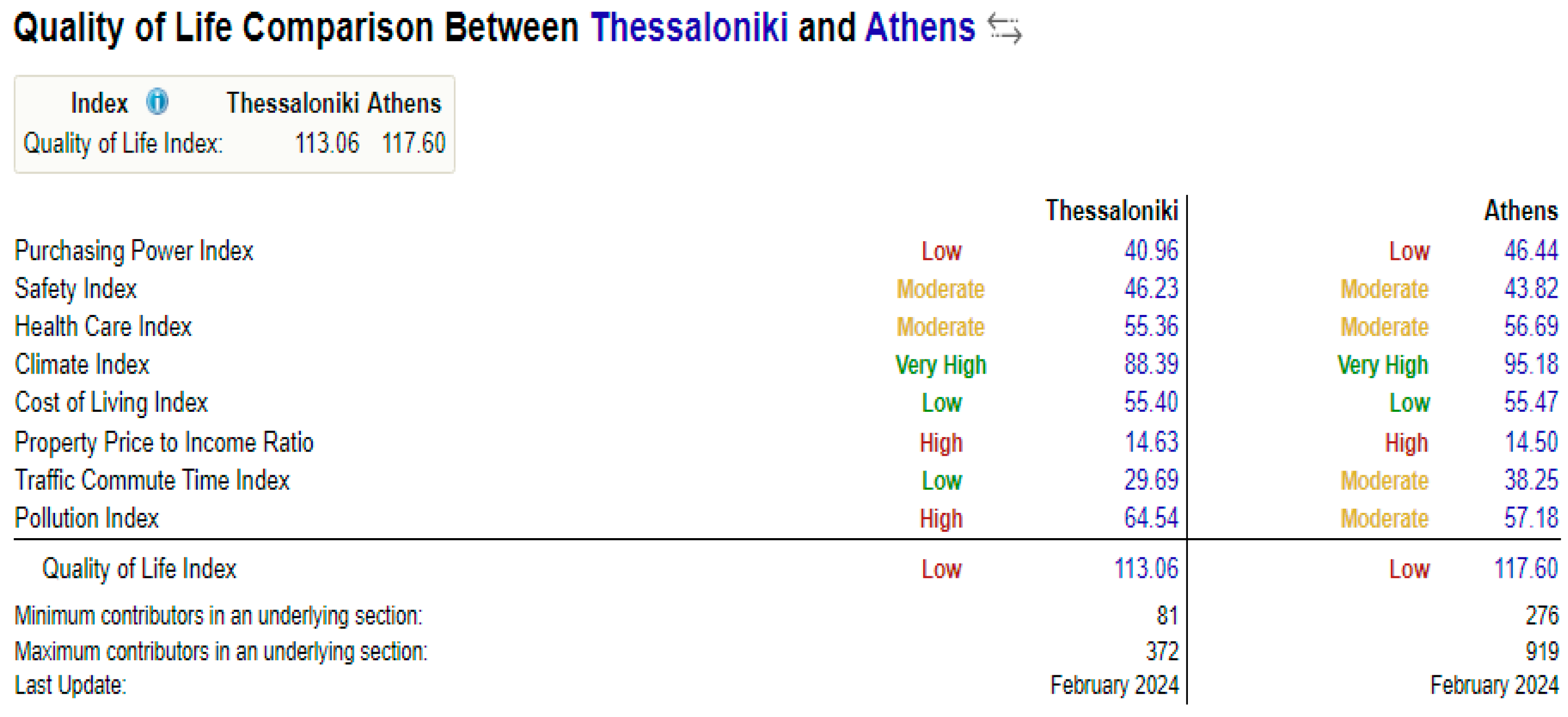Smart Cities, IoT, and e-Government: Applications in Greek Municipalities †
Abstract
1. Introduction
2. The Concept of a “Smart City”: Definitions, Characteristics, Development Framework, and Applications
2.1. Defining Smart Cities
2.2. Features of the Smart City Model
2.3. The Novel e-Government Framework for the Development of Smart Cities
2.4. Classification of Smart City Applications/Actions
2.5. Internet of Things in Smart Cities’ e-Government
3. Current Situation of Smart City Actions in Municipalities in Greece
Indicative Smart City Applications in Municipalities in Greece
4. Discussion
5. Conclusions
Author Contributions
Funding
Institutional Review Board Statement
Informed Consent Statement
Data Availability Statement
Conflicts of Interest
References
- Yin, C.; Xiong, Z.; Chen, H.; Wang, J.; Cooper, D.; David, B. A literature survey on smart cities. Sci. China Inf. Sci. 2015, 58, 1–18. [Google Scholar] [CrossRef]
- Ismagilova, E.; Hughes, L.; Dwivedi, Y.K.; Raman, K.R. Smart cities: Advances in research—An information systems perspective. Int. J. Inf. Manag. 2019, 47, 88–100. [Google Scholar] [CrossRef]
- Lazaroiu, G.C.; Roscia, M. Definition methodology for the smart cities model. Energy 2012, 47, 326–332. [Google Scholar] [CrossRef]
- Wenge, R.; Zhang, X.; Dave, C.; Chao, L.; Hao, S. Smart city architecture: A technology guide for implementation and design challenges. China Commun. 2014, 11, 56–69. [Google Scholar] [CrossRef]
- Albino, V.; Berardi, U.; Dangelico, R.M. Smart Cities: Definitions, Dimensions, Performance, and Initiatives. J. Urban Technol. 2015, 22, 3–21. [Google Scholar] [CrossRef]
- Tahmasseby, S. The Implementation of Smart Mobility for Smart Cities: A Case Study in Qatar. Civ. Eng. J. 2022, 8, 2154–2171. [Google Scholar] [CrossRef]
- O’Grady, M.; O’Hare, G. How smart is your city? Science 2012, 335, 1581–1582. [Google Scholar] [CrossRef]
- Kulkarni, P.; Farnham, T. Smart city wireless connectivity considerations and cost analysis: Lessons learnt from smart water case studies. IEEE Access 2016, 4, 660–672. [Google Scholar] [CrossRef]
- Hammons, R.; Myers, J. Smart Cities. IEEE Internet Things Mag. 2019, 2, 8–9. [Google Scholar] [CrossRef]
- Nelson, A.; Toth, G.; Linders, D.; Nguyen, C.; Rhee, S. Replication of smart-city Internet of Things assets in a municipal deployment. IEEE Internet Things J. 2019, 6, 6715–6724. [Google Scholar] [CrossRef]
- Xiong, Z.; Sheng, H.; Rong, W.G.; Cooper, D.E. Intelligent transportation systems for smart cities: A progress review. Sci. China 2012, 55, 2908–2914. [Google Scholar] [CrossRef]
- Silvia, S. Smart Cities. University of Genova, Italy, IEEE Smart Cities Technical Committee of the IEEE Control Systems Society 2023. Available online: https://www.ieeecss.org/tc/smart-cities (accessed on 18 December 2023).
- European Commission. What Are Smart Cities? 2023. Available online: https://commission.europa.eu/eu-regional-and-urban-development/topics/cities-and-urban-development/city-initiatives/smart-cities_en (accessed on 18 December 2023).
- Abadía, J.J.P.; Walther, C.; Osman, A.; Smarsly, K. A systematic survey of Internet of Things frameworks for smart city applications. Sustain. Cities Soc. 2022, 83, 103949. [Google Scholar] [CrossRef]
- Raspotnik, A.; Grønning, R.; Herrmann, V. A tale of three cities: The concept of smart sustainable cities for the Arctic. Polar Geogr. 2020, 43, 64–87. [Google Scholar] [CrossRef]
- Ruhlandt, R.W.S. The governance of smart cities: A systematic literature review. Cities 2018, 81, 1–23. [Google Scholar] [CrossRef]
- Batty, M.; Axhausen, K.W.; Giannotti, F.; Pozdnoukhov, A.; Bazzani, A.; Wachowicz, M.; Ouzounis, G.; Portugali, Y. Smart cities of the future. Eur. Phys. J. Spec. Top. 2012, 214, 481–518. [Google Scholar] [CrossRef]
- Washburn, U.; Sindhu, S.; Balaouras, R.A.; Dines, N.M.; Nelson, L.E. Initiatives: Defining the Smart City, Its Drivers, and the Role of the CIO; Forrester Research: Cambridge, MA, USA, 2010. [Google Scholar]
- ISO/DIS 37122; Sustainable Development in Communities—Indicators for Smart Cities. International Organization for Standardization: Geneve, Switzerland, 2023. Available online: https://www.iso.org/obp/ui/#iso:std:iso:37122:dis:ed-1:v1:en:e-d1:v1 (accessed on 18 December 2023).
- Tascikaraoglu, A. Evaluation of spatio-temporal forecasting methods in various smart city applications. Renew. Sustain. Energy Rev. 2018, 82, 424–435. [Google Scholar] [CrossRef]
- De Nicola, A.; Villani, M.L. Smart City Ontologies and Their Applications: A Systematic Literature Review. Sustainability 2021, 13, 5578. [Google Scholar] [CrossRef]
- Mohanty, S.P.; Choppali, U.; Kougianos, E. Everything you wanted to know about smart cities: The Internet of Things is the backbone. IEEE Consum. Electron. Mag. 2016, 5, 60–70. [Google Scholar] [CrossRef]
- Lopez-Jurado, M.P.; Perez, A.M.L. Digital assets horizon in smart cities: Urban congestion management by IoT, blockchain/DLT and human reinforcement. Proc. Int. Conf. Model. Simul. Manager. Sci. 2019, 894, 63–82. [Google Scholar]
- Kitchin, R. The real-time city? Big data and smart urbanism. GeoJournal 2014, 79, 1–14. [Google Scholar] [CrossRef]
- Kim, T.H.; Fang, W.C.; Ramos, C.; Mohammed, S.; Gervasi, O.; Stoica, A. Ubiquitous sensor networks and their application. Int. J. Distrib. Sens. Netw. 2012, 8, 310271. [Google Scholar] [CrossRef]
- Kourtit, K.; Nijkamp, P. Smart cities in the innovative age. Innov. Eur. J. Soc. Sci. Res. 2012, 25, 93–95. [Google Scholar] [CrossRef]
- Gracias, J.S.; Parnell, G.S.; Specking, E.; Pohl, E.A.; Buchanan, R. Smart Cities—A Structured Literature Review. Smart Cities 2023, 6, 1719–1743. [Google Scholar] [CrossRef]
- Singh, T.; Sharma, S.; Solanki, A.; Nayyar, A. A Decade Review of Smart Cities: Paradigms, Challenges and Opportunities. IEEE Access 2022, 10, 68319–68364. [Google Scholar] [CrossRef]
- Lee, J.H.; Phaal, R.; Lee, S.-H. An integrated service-device technology roadmap for smart city development. Technol. Forecast. Soc. Chang. 2013, 80, 286306. [Google Scholar] [CrossRef]
- Zanella, A.; Bui, N.; Castellani, A.; Vangelista, L.; Zorzi, M. Internet of Things for smart cities. IEEE Internet Things J. 2014, 1, 22–32. [Google Scholar] [CrossRef]
- Janssen, M.; Charalabidis, Y.; Zuiderwijk, A. Benefits, adoption barriers and myths of open data and open government. Inf. Syst. Manag. 2012, 29, 258268. [Google Scholar] [CrossRef]
- Eichholtz, P.; Kok, N.; Quigley, J.M. Doing well by doing good? Green office buildings. Am. Econ. Rev. 2010, 100, 2492–2509. [Google Scholar] [CrossRef]
- Bill Ash and Srikanth Chandrasekaran. Standards and the Smart City. IEEE Standards Association. Available online: https://www.smartcitiesdive.com/ex/sustainablecitiescollective/standards-and-smart-city/1125560/ (accessed on 21 December 2023).
- Srikanth Chandrasekaran. What a Smart City Is All About. 2021. Available online: https://standards.ieee.org/beyond-standards/what-a-smart-city-is-all-about/ (accessed on 18 December 2023).
- Herath, H.; Mittal, M. Adoption of artificial intelligence in smart cities: A comprehensive review. Int. J. Inf. Manag. Data Insights 2022, 2, 100076. [Google Scholar] [CrossRef]
- Stepaniuk, V.; Pillai, J.; Bak-Jensen, B. Battery energy storage management for smart residential buildings. In Proceedings of the 2018 53rd International Universities Power Engineering Conference (UPEC), Glasgow, UK, 4–7 September 2018; pp. 1–6. [Google Scholar]
- Mohapatra, H. Socio-technical Challenges in the Implementation of Smart City. In Proceedings of the 2021 International Conference on Innovation and Intelligence for Informatics, Computing, and Technologies (3ICT), Virtual Conference, 29–30 September 2021; IEEE: New York, NY, USA, 2021; pp. 57–62. [Google Scholar]
- Khare, Y.; Tiwari, V.P.; Patil, A.B.; Bala, K. Li-Fi technology, implementations and applications. Int. Res. J. Eng. Technol. 2016, 3, 1391–1394. [Google Scholar]
- Li, X.; Liu, H.; Wang, W.; Zheng, Y.; Lv, H.; Lv, Z. Big data analysis of the Internet of Things in the digital twins of smart city based on deep learning. Future Gener. Comput. Syst. 2021, 128, 167–177. [Google Scholar] [CrossRef]
- Ashwini, B.P.; Sitharama, R.M.; Sumathi, R. Artificial Intelligence in Smart City Applications: An overview. In Proceedings of the 2022 6th International Conference on Intelligent Computing and Control Systems (ICICCS), Madurai, India, 25–27 May 2022; IEEE: New York, NY, USA, 2022; pp. 986–993. [Google Scholar]
- Lim, C.; Kim, K.-J.; Maglio, P.P. Smart cities with big data: Reference models, challenges, and considerations. Cities 2018, 82, 86–99. [Google Scholar] [CrossRef]
- Attaran, H.; Kheibari, N.; Bahrepour, D. Toward integrated smart city: A new model for implementation and design challenges. GeoJournal 2022, 87, 511–526. [Google Scholar] [CrossRef] [PubMed]
- Bibri, S.E.; Krogstie, J. Smart sustainable cities of the future: An extensive interdisciplinary literature review. Sustain. Cities Soc. 2017, 31, 183–212. [Google Scholar] [CrossRef]
- Weddell, A.S.; Magno, M. Energy Harvesting for Smart City Applications. In Proceedings of the 2018 International Symposium on Power Electronics, Electrical Drives, Automation and Motion (SPEEDAM), Amalfi, Italy, 20–22 June 2018; IEEE: New York, NY, USA, 2018; pp. 111–117. [Google Scholar]
- Silva, B.N.; Khan, M.; Han, K. Towards sustainable smart cities: A review of trends, architectures, components, and open challenges in smart cities. Sustain. Cities Soc. 2018, 38, 697–713. [Google Scholar] [CrossRef]
- Haque, A.K.M.B.; Bhushan, B.; Dhiman, G. Conceptualizing smart city applications: Requirements, architecture, security issues, and emerging trends. Expert Syst. 2021, 39, 12753. [Google Scholar] [CrossRef]
- Gharaibeh, A.; Salahuddin, M.A.; Hussini, S.J.; Khreishah, A.; Khalil, I.; Guizani, M.; Al-Fuqaha, A. Smart Cities: A Survey on Data Management, Security, and Enabling Technologies. IEEE Commun. Surv. Tutor. 2017, 19, 2456–2501. [Google Scholar] [CrossRef]
- Elberzhager, F.; Mennig, P.; Polst, S.; Scherr, S.; Stüpfert, P. Towards a Digital Ecosystem for a Smart City District: Procedure, Results, and Lessons Learned. Smart Cities 2021, 4, 686–716. [Google Scholar] [CrossRef]
- Akpinar, M.T. Smart City Applications in Digital Age: State-Of-Art Review and Critique. J. Inf. Syst. Manag. Res. 2019, 1, 37–42. [Google Scholar]
- ITU-T Recommendations. Overview of the Internet of Things. 2012. Available online: https://www.itu.int/ITU-T/recommendations/rec.aspx?rec=y.2060 (accessed on 23 December 2023).
- Tcholtchev, N.; Lammel, P.; Scholz, R.; Konitzer, W.; Schieferdecker, I. Enabling the structuring, enhancement and creation of urban ICT through the extension of a standardized smart city reference model. In Proceedings of the 2018 IEEE/ACM International Conference on Utility and Cloud Computing Companion (UCC Companion), Zurich, Switzerland, 17–20 December 2018; pp. 121–127. [Google Scholar] [CrossRef]
- Li, H.; Liu, Y.; Qin, Z.; Rong, H.; Liu, Q. A large-scale urban vehicular network framework for IoT in smart cities. IEEE Access 2019, 7, 74437–74449. [Google Scholar] [CrossRef]
- Δελτίο Τύπου. Υπουργείο Ψηφιακής Διακυβέρνησης. 16 Ιουνίου, 2022. Aνοίγει από 1η Ιουλίου το πρόγραμμα «Έξυπνες Πόλεις» για 315 Δήμους της χώρας. Available online: https://mindigital.gr/archives/3251 (accessed on 24 December 2023).
- Δράσεις και τις προτεραιότητες του υπουργείου Ψηφιακής Διακυβέρνησης. Available online: https://www.metaforespress.gr/autokinitodromoi/%CF%80%CE%B5%CF%81%CE%B9%CF%83%CF%83%CF%8C%CF%84%CE%B5%CF%81%CE%BF%CE%B9-%CE%B1%CF%80%CF%8C-300-%CE%B4%CE%AE%CE%BC%CE%BF%CE%B9-%CE%BA%CE%B1%CF%84%CE%AD%CE%B8%CE%B5%CF%83%CE%B1%CE%BD-%CF%80%CF%81%CE%BF/ (accessed on 24 December 2023).
- Δελτίο Τύπου Ευρωπαϊκής Επιτροπής. H Επιτροπή ανακοινώνει τη συμμετοχή 100 πόλεων στην αποστολή της ΕΕ. Available online: https://ec.europa.eu/commission/presscorner/detail/el/ip_22_2591 (accessed on 24 December 2023).
- Δήμος Hρακλείου. Το όραμα για μια έξυπνη πόλη. Available online: https://smartcity.heraklion.gr/el/our-vision/ (accessed on 24 December 2023).
- Ιστότοπος Έθνος. Πώς τα δίκτυα βοήθησαν το Hράκλειο να γίνει έξυπνη πόλη. Available online: https://www.ethnos.gr/greece/article/164226/postadiktyabohthhsantohrakleionagineiexypnhpolh (accessed on 24 December 2023).
- Πλατφόρμα Aστικής Κινητικότητας του Δήμου Ιωαννιτών. Available online: https://www.smartiscity.gr/dimos-ioanniton/ (accessed on 24 December 2023).
- COSMOTE: Λύσεις Smart Cities με τεχνολογία ΝΒ-ΙοΤ στα Χανιά και τη Μονεμβασιά. Available online: https://www.cosmote.gr/cs/otegroup/gr/smart_cities_monemvasia_chania.html (accessed on 24 December 2023).
- Εφημερίδα Τα Νέα. «Aστυπάλαια—Έξυπνο και Aειφόρο Νησί». Available online: https://www.tanea.gr/2023/11/09/autonea/agora/astypalaia-eksypno-kai-aeiforo-nisi-me-entyposiako-tropo-ekleise-to-proto-9mino-tou-2023-gia-to-programma-astypalaia/ (accessed on 24 December 2023).
- Παρακρητικά. “Έξυπνη πόλη 2022” τα Χανιά, με τέσσερα χρυσά βραβεία. Available online: https://www.parakritika.gr/exypni-poli-2022-ta-chania/ (accessed on 24 December 2023).
- Εφαρμογές Έξυπνης Πόλης Δήμου Χανίων. Available online: https://www.smartiscity.gr/dimos-chanion/ (accessed on 24 December 2023).
- Dashkevych, O.; Portnov, B.A. Criteria for Smart City Identification: A Systematic Literature Review. Sustainability 2022, 14, 4448. [Google Scholar] [CrossRef]
- ISO 37122:2019; Sustainable Cities and Communities—Indicators for Smart Cities. International Organization for Standardization: Geneve, Switzerland, 2019.
- Jayasena, N.S.; Chan, D.W.M.; Kumaraswamy, M.M.; Saka, A.B. Applicability of public-private partnerships in smart infrastructure development: The case of Hong Kong. Int. J. Constr. Manag. 2022, 23, 1932–1944. [Google Scholar] [CrossRef]
- Lnenicka, M.; Nikiforova, A.; Luterek, M.; Azeroual, O.; Ukpabi, D.; Valtenbergs, V.; Machova, R. Transparency of open data ecosystems in smart cities: Definition and assessment of the maturity of transparency in 22 smart cities. Sustain. Cities Soc. 2022, 82, 103906. [Google Scholar] [CrossRef]
- Kuzior, A.; Pakhnenko, O.; Tiutiunyk, I.; Lyeonov, S. E-Governance in Smart Cities: Global Trends and Key Enablers. Smart Cities 2023, 6, 1663–1689. [Google Scholar] [CrossRef]
- IMD Smart City Index 2023. Available online: https://imd.cld.bz/IMD-Smart-City-Index-Report-20231 (accessed on 20 February 2024).
- NUMBEO. Available online: https://www.numbeo.com/quality-of-life/ (accessed on 20 February 2024).
- NUMBEO, Quality of Life Index by Country 2024. Available online: https://www.numbeo.com/quality-of-life/rankings_by_country.jsp (accessed on 20 February 2024).
- NUMBEO, Quality of Life Index in Greece 2024. Available online: https://www.numbeo.com/quality-of-life/compare_cities.jsp?country1=Greece&city1=Thessaloniki&country2=Greece&city2=Athens (accessed on 20 February 2024).
- NUMBEO, Quality of Life Index in Heraklion 2024. Available online: https://www.numbeo.com/quality-of-life/in/Heraklion. (accessed on 24 February 2024).
- Ahad, M.A.; Paiva, S.; Tripathi, G.; Feroz, N. Enabling technologies and sustainable smart cities. Sustain. Cities Soc. 2020, 61, 102301. [Google Scholar] [CrossRef]
- Cassandras, C.G. Smart Cities as Cyber-Physical Social Systems. Engineering 2016, 2, 156–158. [Google Scholar] [CrossRef]
- Khan, I.H.; Khan, M.I.; Khan, S. Challenges of IoT Implementation in Smart City Development. In Smart Cities—Opportunities and Challenges; Springer: Singapore, 2020; pp. 475–486. [Google Scholar]
- Rathore, M.M.; Ahmad, A.; Paul, A.; Rho, S. Urban planning and building smart cities based on the Internet of Things using Big Data analytics. Comput. Netw. 2016, 101, 63–80. [Google Scholar] [CrossRef]
- Merline, M.A.; Vimalathithan, R. Smart city: Issues and research challenges in implementation. In Proceedings of the 2017 IEEE International Conference on Smart Grid and Smart Cities (ICSGSC), Singapore, 23–26 July 2017; IEEE: New York, NY, USA, 2017; pp. 263–266. [Google Scholar]
- Angelidou, M. Four European Smart City Strategies. Int. J. Soc. Sci. Stud. 2016, 4, 18–30. [Google Scholar] [CrossRef]
- Alsamhi, S.H.; Ma, O.; Ansari, M.S.; Almalki, F.A. Survey on Collaborative Smart Drones and Internet of Things for Improving Smartness of Smart Cities. IEEE Access 2019, 7, 128125–128152. [Google Scholar] [CrossRef]
- Din, I.U.; Guizani, M.; Rodrigues, J.J.P.C.; Hassan, S.; Korotaev, V.V. Machine Learning on the Internet of Things: Designed techniques for smart cities. Future Gener. Comput. Syst. 2019, 100, 826–843. [Google Scholar] [CrossRef]




Disclaimer/Publisher’s Note: The statements, opinions and data contained in all publications are solely those of the individual author(s) and contributor(s) and not of MDPI and/or the editor(s). MDPI and/or the editor(s) disclaim responsibility for any injury to people or property resulting from any ideas, methods, instructions or products referred to in the content. |
© 2025 by the authors. Licensee MDPI, Basel, Switzerland. This article is an open access article distributed under the terms and conditions of the Creative Commons Attribution (CC BY) license (https://creativecommons.org/licenses/by/4.0/).
Share and Cite
Glaroudis, D.; Sampsonidou, A.; Papaioannou, E. Smart Cities, IoT, and e-Government: Applications in Greek Municipalities. Proceedings 2024, 111, 26. https://doi.org/10.3390/proceedings2024111026
Glaroudis D, Sampsonidou A, Papaioannou E. Smart Cities, IoT, and e-Government: Applications in Greek Municipalities. Proceedings. 2024; 111(1):26. https://doi.org/10.3390/proceedings2024111026
Chicago/Turabian StyleGlaroudis, Dimitrios, Alexandra Sampsonidou, and Eugenia Papaioannou. 2024. "Smart Cities, IoT, and e-Government: Applications in Greek Municipalities" Proceedings 111, no. 1: 26. https://doi.org/10.3390/proceedings2024111026
APA StyleGlaroudis, D., Sampsonidou, A., & Papaioannou, E. (2024). Smart Cities, IoT, and e-Government: Applications in Greek Municipalities. Proceedings, 111(1), 26. https://doi.org/10.3390/proceedings2024111026





